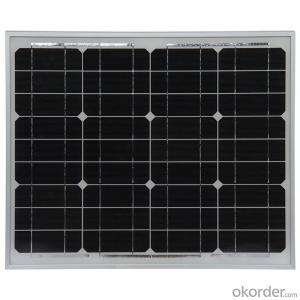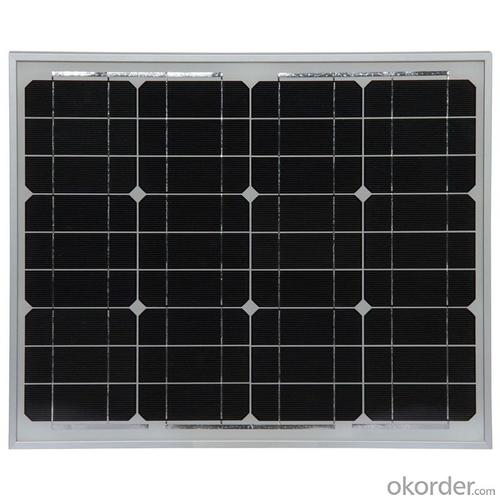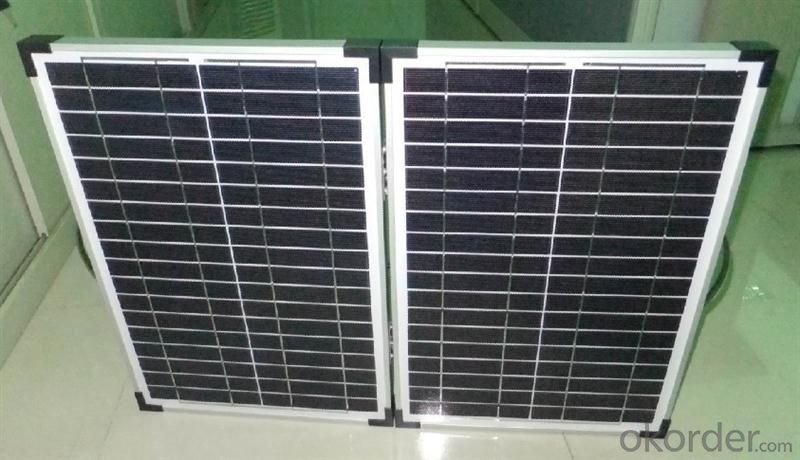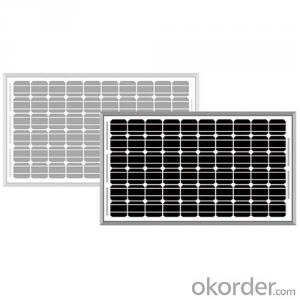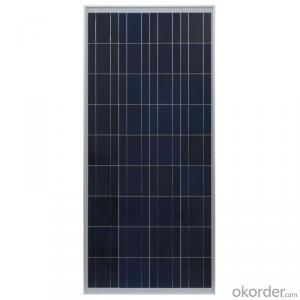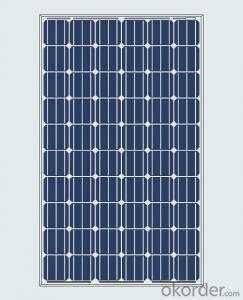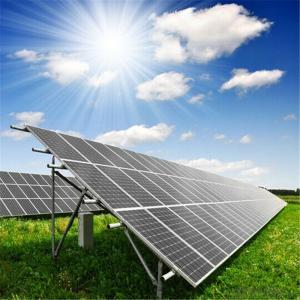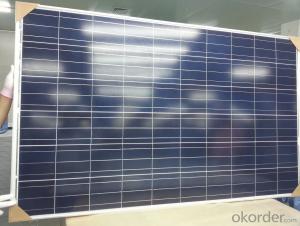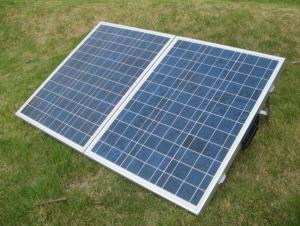300W Poly-Si Mono-Crystalline Solar Panel for PV Power Station
- Loading Port:
- Shanghai
- Payment Terms:
- TT OR LC
- Min Order Qty:
- 1000 watt
- Supply Capability:
- 1000000 watt/month
OKorder Service Pledge
OKorder Financial Service
You Might Also Like
Specification
Product Description
monocrystalline Solar Panel 300w for pv power station
Our solar panel has always been a best seller. It features A-grade high efficiency monocrystalline solar cells and is assembled in compliance with our unique quality standards. The solar panel not only is a preferred option for residential systems, but also proved to be a great match for commercial, large-scale and standalone applications.
Features
1.High reliability with guaranteed -3% to +5% power output tolerance, ensuring return on investment
2.High conversion efficiency based on leading innovative photovoltaic technologies
3.Withstands high wind-pressure and snow load, and extreme temperature variations
4.Attractive appearanceUnique frame design, high mechanical strength, and easy Installation
Material
1.Solar cell-conversion efficiency of solar cell: 24%-17%
2.Front glass-3.2mm, high transmission, low iron, tempered glass
3.EVA-excellent anti-aging resistance
4.TPT-hot seal made of flame resistance
5.Flame-reinfored anodixed aluminum flame
6.Junction box-Ip54 rated and Ip65 rated, high quality, with diode protection
Warranty
1) 10 years for material & workmanship;
2) 10 years for 90% power output;
3) 20 ears for 80% power output.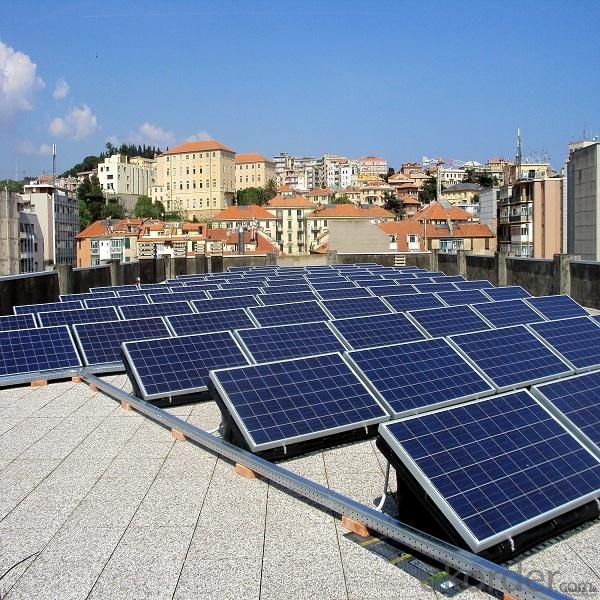
Packaging & Delivery
1. Packaging Detail: 2PCS/CARTON; 504PCS/40'; 520PCS/40'H
2. Delivery Detail: 10-15 days after receiving deposit
Customer Stories&Applications
1. Any large or small on-grid or off-grid solar power stations.
2. Commercial and industrial building roof-top systems
3. Resident systems.
4. Any commercial or industrial ground mounting systems 5. solar television, Solar power, solar heater, solar lights, Highway solar street lamp, solar car / electric vehicles, satellites, spacecraft, space solar power plant, energy saving lamp, the field of environmental protection.
WHY US?
1. We have our own production line of solar cells.
2. Our solar panels are good quality with OEM service.
Our products are backed by an industry standard 5/10/25 warranty to assure the longevitiy of your system. Not only this, we assure the quality of our modules with 100% infrared scanning to go with our standard quality assurance procedures. Depending on the availability by your location, we may also be able to offer liability insurance coverage for our products.
| Place of Origin: | Guangdong, China (Mainland) |
| Material: | monocrystalline silicon |
| Max. Power: | 300W |
| Conversion efficiency: | 17.26% |
| Module size (mm): | 992*1950*50mm |
| Cell Type | 156*156/6*12 |
| Nominal voltage(V): | 36.2 |
| Nominal current (A): | 8.29 |
| Open circuit voltage (Voc): | 44.9 |
| Short cirsuit current(Isc): | 8.95 |
| Power tolerance: | -3%to+5% |
| NOCT: | 45± 2%/degree |
| Temperature coefficient of Voc: | -0.34%/degree |
| Temperature coefficient of Isc: | 0.017%/degree |
| Temperature coefficient of Pmax: | -0.48%/degree |
| Operating temperature: | -40/degree to+85/degree |
| Certifications | ISO 9001 TUV CE RoHS |
| Maximum system voltage: | 1000V DC, 600V |
FAQ:
1.Price per watt?
It depends on the quantity, delivery date and payment terms.
2.Parameter of the module?
We have different series of panels in different output, both c-si and a-si. please take the specification sheet for your reference.
3.Can you provide the peripheral products of the solar panels, such as the battery, controller etc.?
We have two companies(CNBM International & CNBM engineering Co.) with different approaches. We can supply not only the solar module but also Solar Cells, off grid solar system, even service with on grid plant.
4.Warranty policy?
Our product performance guarantees for 25 years
• 12 years guarantee for workmanship
• Timeliness of delivery
• Quality Products certified (TÜV, UL, CE, ISO)
5.Lead time?
In 3 days after purchasing, we will arrange the factory delivery ASAP. The specific time of receiving is related to the state and position of customers. Commonly 7 to 10 working days can be served.
- Q: Do solar panels require maintenance?
- Yes, solar panels do require some maintenance. Regular cleaning to remove dirt and debris is necessary to ensure optimal performance. Additionally, checking for any signs of damage, such as cracks or loose connections, is important. Routine inspections and occasional repairs or replacements may be needed to keep the solar panels functioning efficiently.
- Q: Are there any restrictions or regulations regarding solar panel installations?
- Yes, there are restrictions and regulations regarding solar panel installations. These can vary depending on the location and jurisdiction. Common regulations include obtaining permits, adhering to building codes and zoning requirements, maintaining a certain distance from property lines, and complying with electrical and safety standards. It is important to consult with local authorities and professionals to ensure compliance with all applicable regulations before installing solar panels.
- Q: Can solar panels be installed in a remote location?
- Yes, solar panels can be installed in remote locations. In fact, remote areas with limited access to electricity grids can greatly benefit from solar panel installations. Solar panels are designed to operate independently and generate electricity from sunlight, making them an ideal solution for off-grid locations. They can be installed in remote areas such as deserts, mountains, or even on boats, providing a reliable and sustainable source of power.
- Q: Can solar panels be used in areas with high pollution levels?
- Yes, solar panels can be used in areas with high pollution levels. While pollution levels may slightly reduce the efficiency of solar panels due to decreased sunlight reaching the panels, they can still generate electricity. Additionally, solar panels can help mitigate pollution by providing clean and renewable energy, reducing reliance on fossil fuels and contributing to a cleaner environment.
- Q: Are solar panels worth the investment?
- Yes, solar panels are worth the investment. They have numerous long-term benefits such as significant energy savings, reduction in electricity bills, and a positive environmental impact by reducing carbon emissions. Additionally, many governments offer incentives and tax credits for installing solar panels, further enhancing the return on investment.
- Q: I'm looking to see how much it would be to install solar panels on a home. Or more information on where i would be able to locate a place of purchase, or in general more information...
- A Solar panel usually cost between $0,000-20,000 and more. If you're not wanting to spend that much, I suggest you try the DIY solar panel guides. These are step-by-step guides in building solar panels. They are very cheap and overall, you can get solar panels for less than $200. The guide will help you choose where to buy and what to buy so you won't spend thousands of dollars. Whether you're a beginner or an expert, you can do it. If you're interested, just click on the link below. I also added some links where you can read reviews about these guides. Goodluck!
- Q: How much energy can solar panels produce?
- The amount of energy solar panels can produce depends on various factors such as the size and efficiency of the panels, the location and climate, and the amount of sunlight available. On average, a typical residential solar panel system can generate anywhere from 4,000 to 8,000 kilowatt-hours (kWh) of electricity per year. However, larger commercial or utility-scale solar installations can produce significantly more energy, potentially reaching several megawatts of power.
- Q: Can solar panels be installed on a university or college campus?
- Yes, solar panels can be installed on a university or college campus. In fact, many educational institutions have already embraced solar energy as a way to reduce their carbon footprint and promote sustainability. Installing solar panels on campus buildings can provide clean, renewable energy, reduce electricity costs, and serve as an educational tool for students to learn about renewable energy technologies.
- Q: How long does it take to install solar panels?
- The installation process for solar panels typically takes one to three days, depending on the size and complexity of the system, as well as the availability of skilled installers.
- Q: I am looking at building my own solar panels to at least help cut down the rising energy bill. I know its expensive. I already have the solar cells so no need to worry about listing that. But i am looking at wiring it directly into the house. Is there any parts that you could list for me, that would be great. thanks
- You're missing a few assumptions: - where on the globe? - how well is your house insulated, how do you plan to heat/cool your house? - why do you insist on power wasting appliances like plasma screens? Usually, unless it's absolutely impossible, a grid-tie-in system is much better than an insular system. You could use the grid to 'store' electricity for those times when the sun isn't shining and as fall-back if your yield isn't quite as good as you calculated. With the battery system, you'll have to specify your reliability requirements. If you want a 00% guarantee that you'll always have electricity, even if the sun is not shining for a week longer than you've planned according to the past weather history of your area, you'll either have to ridiculously oversize your battery (and panel) system, or plan for some sort of backup system anyway. Finally, if you're really planing such a system, you might want to take a look at the fridges and freezers used on sailboats: these use a eutectic cold accumulator, i.e. you 'charge' the fridge when the engine is running (or the sun is shining) and it'll then keep the temperature for another ~2...35 (professional systems) hours.
Send your message to us
300W Poly-Si Mono-Crystalline Solar Panel for PV Power Station
- Loading Port:
- Shanghai
- Payment Terms:
- TT OR LC
- Min Order Qty:
- 1000 watt
- Supply Capability:
- 1000000 watt/month
OKorder Service Pledge
OKorder Financial Service
Similar products
Hot products
Hot Searches
Related keywords
